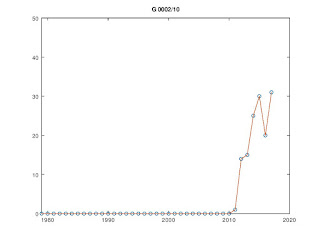No. of citations: 145
G 2/10 is concerned with the question of whether and when "disclosed disclaimers" are allowed. Disclosed disclaimers are amendments by which certain embodiments, which are disclosed as embodiments of the invention, are excluded from the scope of a generically formulated claim. G 2/10 follows G 1/03 and G 2/03, which dealt with the admissibility of "non-disclosed" disclaimers, i.e., with the conditions under which disclaimers disclaiming subject matter which was not disclosed at all in the original application could be disclaimed.
In the underlying examination case, the applicant amended a claim to a catalytic DNA molecule having site-specific endonuclease activity specific for a nucleotide sequence. The definition of the claimed DNA molecule was generic, in that it allowed certain variations in the nucleotide sequence. The applicant amended the original claim by disclaiming from its scope certain sequences, which were originally disclosed as embodiments of the invention. Claim 1 of the Main request read:
"1. A catalytic DNA molecule having site-specific endonuclease activity [...] said molecule having the formula:
[...]
... wherein the first substrate binding region does not have the sequence 5'-CTTTGGTTA-3' or 5'-CTAGTTA-3',
wherein the second substrate binding region does not have the sequence 5'-TTTTTCC 3'-and
wherein the said catalytic DNA molecule does not show site-specific endonuclease activity for the sequence: 5'–GGAAAAAGUAACUAGAGAUG-GAAG–3' (SEQ ID NO 135)."Before G 2/10, it was common practice at the EPO to allow such disclaimers of embodiments, which were presented as part of the invention.
The Enlarged Board, however, considered that there was no reason to generally allow such disclosed disclaimers, because the overriding principle for assessing the admissibility of amendments during prosecution was still Art. 123(2) EPC.
They considered that undisclosed disclaimers are not allowed, unless the subject matter remaining within the claim after the disclaimer can be directly and unambiguously be derived from the application as filed.
This test was later referred to as the "remaining subject matter test" of G 2/10.
---
Headnote:
The question referred to the Enlarged Board of Appeal is answered as follows:
1a. An amendment to a claim by the introduction of a disclaimer disclaiming from it subject-matter disclosed in the application as filed infringes Article 123(2) EPC if the subject-matter remaining in the claim after the introduction of the disclaimer is not, be it explicitly or implicitly, directly and unambiguously disclosed to the skilled person using common general knowledge, in the application as filed.
1b. Determining whether or not that is the case requires a technical assessment of the overall technical circumstances of the individual case under consideration, taking into account the nature and extent of the disclosure in the application as filed, the nature and extent of the disclaimed subject-matter and its relationship with the subject-matter remaining in the claim after the amendment.The full text of the decision can be found here.

No comments:
Post a Comment